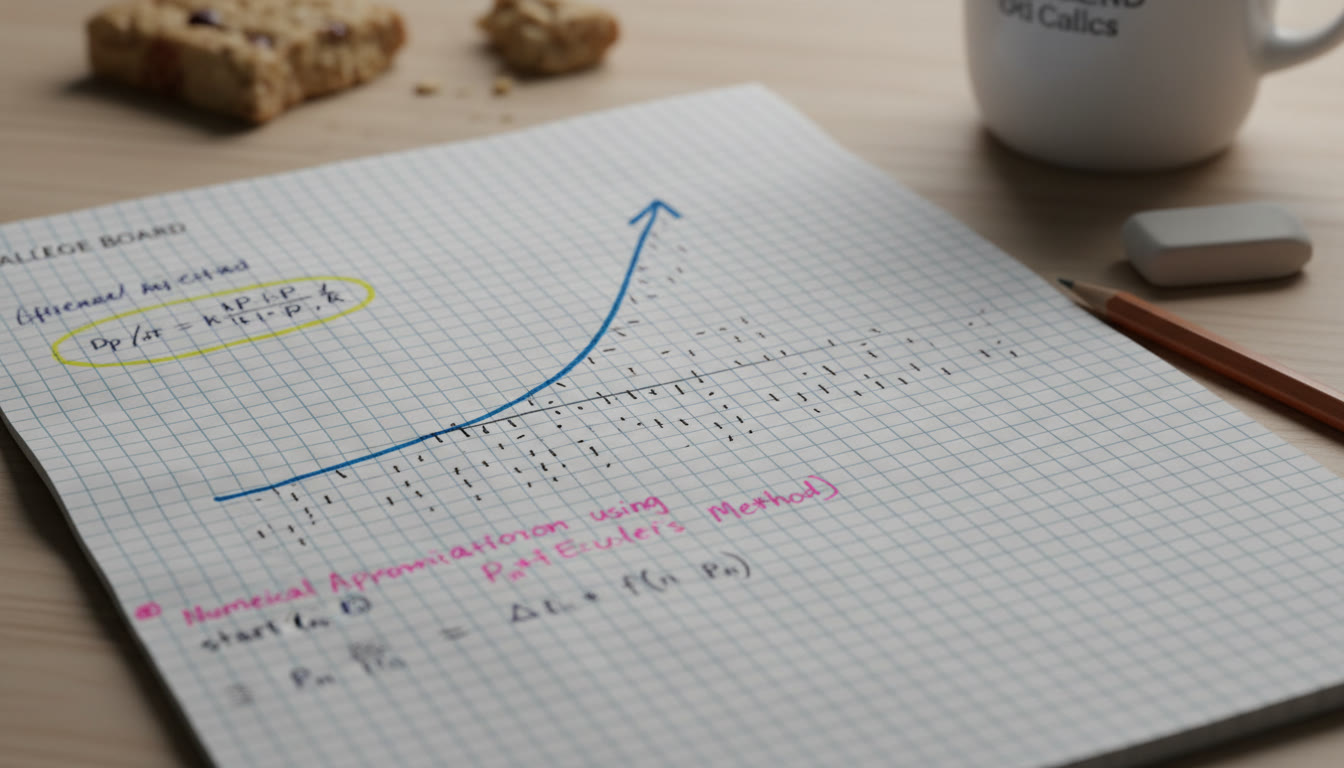Introduction: Why Euler’s Method and Logistic Models Matter on the Calc BC FRQ
If you’ve spent any time with AP Calculus BC free-response questions, you know they love to blend conceptual thinking with careful computation. Two topics that crop up regularly — and reward clear, methodical answers — are Euler’s Method and logistic growth models. Together they test your grasp of differential equations from different angles: Euler’s Method asks, “How do we numerically approximate a solution?” while logistic models ask, “How does a population (or anything bounded) evolve under limited resources?”

What AP graders look for
On the Calc BC FRQ, graders reward answers that are correct, clear, and communicative. That means showing work in organized steps, labeling units when appropriate, and explaining why you used a particular method. When you write numerical approximations from Euler’s Method, include the step size and intermediate values (unless the prompt asks you to summarize). For logistic models, clearly state initial conditions, carry out algebraic manipulations carefully, and interpret parameters in context.
Part 1 — Euler’s Method: Practical, Approximate, and Powerful
The idea in plain English
Euler’s Method is a stepwise technique to approximate the value of a solution y(x) to a first-order differential equation y’ = f(x,y) when an analytic solution is hard or unnecessary. Starting from a known point (x0, y0), you advance by tiny steps h, using the slope f(x_n, y_n) at the beginning of each interval to estimate the next point. Geometrically, you’re drawing tangent-line segments to approximate the curve.
Step-by-step algorithm
- Given y’ = f(x,y), initial point (x0, y0), and step size h, compute x_{n+1} = x_n + h.
- Compute y_{n+1} = y_n + h * f(x_n, y_n).
- Repeat until you reach the desired x.
Tips for the FRQ
- Always state the step size h explicitly and show at least the first one or two iterations unless the problem asks otherwise.
- Keep intermediate values to a reasonable number of decimal places; if the prompt asks for three decimal places, follow it.
- If asked to compare Euler’s Method to the actual solution, compute the error (actual minus approximate) and note how it changes as h changes.
- When the slope depends only on y (autonomous), mention that you’re using the same slope formula but with specific x if required.
Example FRQ-style problem (guided)
Suppose y’ = 0.5y – x, with y(1) = 2. Use Euler’s Method with step size h = 0.2 to approximate y(1.4). Show your iterations and compute the approximation at x = 1.4.
Work (concise and exam-friendly):
- n=0: x0 = 1.0, y0 = 2.0.
- h = 0.2, so points are x = 1.0, 1.2, 1.4.
- f(x0,y0) = 0.5(2.0) – 1.0 = 1.0 – 1.0 = 0.0 → y1 = y0 + h*f = 2.0 + 0.2*0 = 2.0.
- f(x1,y1) at x1=1.2, y1=2.0: 0.5(2.0) – 1.2 = 1.0 – 1.2 = -0.2 → y2 = 2.0 + 0.2*(-0.2) = 2.0 – 0.04 = 1.96.
- Therefore y(1.4) ≈ 1.96.
On the exam, present the iterations clearly and box the final approximation. If the prompt asks, compute absolute error using the actual analytic solution (if available).
Part 2 — Logistic Models: Bounded Growth with a Story
From real life to differential equation
Logistic models arise when growth is self-limiting — for populations, resources become scarce; for diffusion of a new technology, the market saturates. The logistic differential equation typically appears as
dy/dt = k y (1 – y/M)
where k is the intrinsic growth rate and M is the carrying capacity (the maximum sustainable population). The model balances exponential tendency (ky) with a negative feedback factor (1 – y/M).
Solving and interpreting the logistic equation (exam-style clarity)
The logistic equation is separable. A concise FRQ-style solution outline:
- Separate variables: dy/[y(1 – y/M)] = k dt.
- Use partial fractions: 1/[y(1 – y/M)] = (1/y) + (1/(M – y)) * (1/M) after algebraic decomposition (show the decomposition steps on the FRQ).
- Integrate both sides to get ln|y| – ln|M – y| = kt + C, which rearranges to y(t) = M / (1 + Ae^{-kt}), where A depends on initial condition.
- Fit A using y(0) or the given initial value: A = (M – y0)/y0.
What AP graders expect
Write the solution cleanly and explain parameters in context. If the FRQ gives real numbers for k and M, compute them and interpret: “k = 0.3 per year indicates a relatively fast growth rate; M = 1000 indicates the long-term limit is 1000 individuals.” When asked for long-term behavior, explicitly take the limit as t → ∞ and state y → M.
Common FRQ prompts and how to answer them
- Find explicit solution: Show separation, partial fractions, integration, and constant-finding. Don’t skip algebraic steps that connect initial condition to A.
- Interpret parameters: Link k and M to growth speed and limit, and explain what happens if k changes sign or M changes.
- Compare logistic to exponential: Show that logistic behaves like exponential when y is tiny (since 1-y/M ≈ 1), and explain saturation when y is near M.
Bridging the Two: When Euler’s Method Meets Logistic Models
Why you might use Euler’s Method on a logistic FRQ
Sometimes FRQs will give a logistic differential equation but ask for numerical approximations at particular times or examine the effect of different step sizes. In those cases, Euler’s Method is perfectly valid — but you must be careful because logistic slopes change rapidly near mid-population values and Euler’s Method can lose accuracy if h is too large.
Exam strategy: accuracy vs. time
If an FRQ asks for approximate values and gives small step sizes, follow the algorithm and show your work. If the step size is impractically small for manual calculation, the question will usually ask you to write a general formula for the n-th step or to compare error behavior between two choices of h. Always state the potential for error; e.g., “With h = 0.5 the approximation deviates by approximately 3% compared to h = 0.25” — and show how you estimated that deviation.
Worked Example: Logistic Model with Numerical Approximation
Walk through a complete, exam-style problem that combines both ideas.
Problem statement (FRQ-style)
A certain fish population in a lake is modeled by the logistic differential equation dP/dt = 0.6P(1 – P/500), where P is the population and t is measured in years. Initial population P(0) = 50. (a) Find the explicit solution P(t). (b) Use Euler’s Method with h = 1 to approximate P(3). (c) Compare the Euler approximation with the exact value and interpret.
Solution (concise, grader-friendly)
- (a) Separate: dP/[P(1 – P/500)] = 0.6 dt. Partial fractions and integrate to get ln(P) – ln(500 – P) = 0.6t + C. Solve: P(t) = 500 / (1 + A e^{-0.6t}). Use P(0) = 50 → 50 = 500/(1 + A) ⇒ 1 + A = 10 ⇒ A = 9. So P(t) = 500/(1 + 9 e^{-0.6t}).
- (b) Euler’s Method with h = 1. Start P0 = 50 at t0 = 0. Compute slopes f(t,P) = 0.6P(1 – P/500).
| Step | t | P (start) | f(t,P) | P (next) = P + h*f |
|---|---|---|---|---|
| 0 | 0 | 50.00 | 0.6*50*(1 – 50/500) = 30*(0.9) = 27.00 | 77.00 |
| 1 | 1 | 77.00 | 0.6*77*(1 – 77/500) = 46.2*(0.846) ≈ 39.11 | 116.11 |
| 2 | 2 | 116.11 | 0.6*116.11*(1 – 116.11/500) ≈ 69.666*(0.76778) ≈ 53.49 | 169.60 |
After three steps (t = 3) Euler approximation yields P(3) ≈ 169.60.
- (c) Exact value: P(3) = 500 / (1 + 9 e^{-0.6*3}) = 500 / (1 + 9 e^{-1.8}). Compute e^{-1.8} ≈ 0.1653 → denominator ≈ 1 + 9*0.1653 = 1 + 1.4877 = 2.4877 → P(3) ≈ 500/2.4877 ≈ 200.95.
- Comparison: Euler’s approximation 169.60 underestimates the true value 200.95. Absolute error ≈ 31.35, relative error ≈ 15.6%.
Interpretation: With h = 1, Euler’s Method underestimates because the logistic slope increases in the early phase of growth; smaller h would reduce the error. On an FRQ, explicitly comment on why the error occurs and how decreasing h would improve accuracy.
Exam-Ready Tips & Shortcuts
Quick checklist for FRQs involving these topics
- Write the differential equation and initial conditions clearly at the top.
- For Euler’s Method: state h, write at least two steps, and box your approximate value.
- For logistic equations: show separation, partial fraction decomposition, and constant solving from initial conditions.
- If asked for behavior as t → ∞, compute the limit and state the interpretation in words.
- If comparing methods or step sizes, provide numerical evidence (two approximations or error estimates).
Time-saving algebra tips
- When doing partial fractions for logistic models, write the decomposition fully before integrating — this avoids sign mistakes.
- Keep factors like M in symbolic form until you plug in numbers — it reduces algebraic clutter and makes your reasoning easier to follow.
- For Euler’s iterations, set up a small table (like the one above). Tables are easy for graders to scan and reward organization.
Common Pitfalls and How to Avoid Them
Pitfall: Dropping steps to save time
Students often skip algebraic steps to save time, but graders penalize missing justification. Even when you know the path, write the crucial intermediate steps: the separation step for logistics and at least one Euler iteration.
Pitfall: Misinterpreting parameters
When the question is contextual (population, concentration, etc.), explicitly connect parameters to the scenario. If k is negative, explain that the model predicts decay rather than growth.
Pitfall: Forgetting units or context
If the FRQ gives units (e.g., years, individuals), include them in your final interpretation. A sentence like “As t → ∞, P(t) → 500 individuals” communicates both the math and the context.
Practice Resources and How to Use Them Efficiently
Targeted practice beats random problem grinding. Pick 8–12 FRQs that specifically focus on numerical methods and logistic models. For each problem:
- Time yourself for the first attempt, then redo without the clock focusing on clarity of steps.
- Compare approximate methods (Euler with different h) to analytic solutions to build intuition about error.
- Write short, 1–2 sentence interpretations after each solution — that’s often where easy points are earned on the FRQ.
For students wanting personalized support, consider working with a tutor who can create a tailored study plan, provide 1-on-1 guidance on weak spots, and give quick feedback on FRQ style and exposition. Sparkl’s personalized tutoring — with expert tutors and AI-driven insights — can be helpful for targeted practice and pacing strategies when preparing for AP Calculus BC.
Summary Table: Quick Reference
| Concept | Core Formula / Idea | FRQ Tip |
|---|---|---|
| Euler’s Method | y_{n+1} = y_n + h f(x_n,y_n) | State h, show iterations, keep intermediate values. |
| Logistic Equation | dy/dt = k y (1 – y/M) → y(t) = M/(1 + A e^{-kt}) | Show separation, partial fractions, solve A with initial condition. |
| Long-term Behavior | lim_{t→∞} y(t) = M | State limit and interpret in context (e.g., carrying capacity). |
| Error Insight | Smaller h → smaller local truncation error; logistic slopes can change quickly | Compare approximations for two h values and discuss direction of error. |
Final Thoughts: Make FRQs Your Zone of Strength
Euler’s Method and logistic models both reward carefulness and clear writing. A methodical approach — state your assumptions, show structured steps, and interpret results — wins points consistently. Practice with intention: compare analytic vs. numeric, make tidy tables of iterations, and get comfortable explaining what parameters mean in plain language.
If you want to accelerate your learning curve, working with a tutor who provides personalized study plans and focused, context-rich feedback can make a big difference. Sparkl’s personalized tutoring blends expert tutors with data-driven insights to help you tighten technique and polish FRQ presentation — a great option if you want targeted help mastering these classic Calc BC topics.
Go into the exam with clarity: know your steps, keep answers neat, and treat each FRQ like a mini-argument — make a clear claim, support it with math, and conclude with interpretation. You’ve got this.

Good luck, and remember: accuracy is important, but explainability is what convinces a grader that you truly understand the math.


















No Comments
Leave a comment Cancel